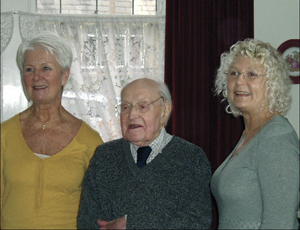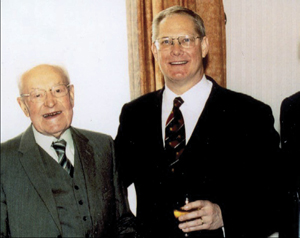Ronald Kaye
Internationally renowned academic and polarography expert, Ronnie Kaye, studied Pharmacy part-time from the late 1920s and once qualified, lectured in Pharmacy until the early 1960s, at Bradford Technical College.
Ronnie left school in Huddersfield at 15 and became an
apprentice in his uncle’s pharmacy there, studying part-time
at Bradford Technical College. He obtained his College
Diploma in Pharmacy and 2nd class honours in his external
London degree in 1936. He registered as a pharmacist
in 1937 and then taught at Bradford Technical College,
becoming a Senior Lecturer in Pharmacy, before leaving to
become Head of Pharmacy at Leeds University.
His exceptional talents and ingenuity meant that he was
not unduly troubled by spending many years in a Technical
College with only a teaching budget, rather than the generous
research budget a university could offer. He was able to
make the necessary savings to fund his research by making
his own electrochemical apparatus, including a sensitive
galvanometer, which when independently tested matched
the most stringent standards of the any available model.
His familiarity with electronics partly stemmed from a
longstanding interest in broadcasting. He was a keen radio
ham, transmitting from being a young lad until his death.
 In 1930, when he was only 17, Ronnie received images
from Crystal Palace using his own device made from a radio
receiver, neon bulb and water-powered imaging disc, at a
cost of just for 3s 11d. His daughter, Pauline remembers
him making an improvised television in 1952. “It wasn’t
in a cabinet or anything but was a Heath Robinson style
contraption of wires and a 9 inch screen. You turned it on
by using a ruler while lying on the floor! But it worked and
half the neighbourhood crammed into our living room to
watch the Queen’s coronation. He finally made a cabinet for
it about 10 years later – my mother went bananas about it
being a dust magnet!”
In 1930, when he was only 17, Ronnie received images
from Crystal Palace using his own device made from a radio
receiver, neon bulb and water-powered imaging disc, at a
cost of just for 3s 11d. His daughter, Pauline remembers
him making an improvised television in 1952. “It wasn’t
in a cabinet or anything but was a Heath Robinson style
contraption of wires and a 9 inch screen. You turned it on
by using a ruler while lying on the floor! But it worked and
half the neighbourhood crammed into our living room to
watch the Queen’s coronation. He finally made a cabinet for
it about 10 years later – my mother went bananas about it
being a dust magnet!”
A self-taught linguist, Ronnie read research papers in his
specialist field in Russian and Serbo-Croat. He was also
fluent in French, which he used to read the French classics,
for holidays and for his broadcasts (also in Russian). Truly a
renaissance man, Ronnie was also a talented cellist, playing,
teaching, and performing locally, often stepping in to the
breach in the orchestra pit at the Alhambra.
However, he was primarily a passionate teacher and
researcher. An internationally recognised expert on
polarography, he gained his PhD in 1952, while teaching at
Bradford and over the years published widely and supervised
many research students at Leeds. He is remembered as a
gifted teacher who made complex ideas absorbing and who
had vision to recognise and develop potential.
 In 1964 he interviewed a young man with a passion for
chemistry but who was dreadful at maths and had never
taken physics, so misunderstood the interview questions,
for a place on a pharmacy degree at Leeds. It was not
a promising start but Ronnie later admitted that he had
been intrigued by the headmaster’s letter which stated the
candidate was ‘an unusual young man’ and then repeated
the statement in capitals. V Craig Jordan is now universally
regarded as one of the most important medical scientists
in the world having guided the clinical development of
Tamoxifen for 25 years. Ronnie’s instinct has benefited
many thousands of women.
In 1964 he interviewed a young man with a passion for
chemistry but who was dreadful at maths and had never
taken physics, so misunderstood the interview questions,
for a place on a pharmacy degree at Leeds. It was not
a promising start but Ronnie later admitted that he had
been intrigued by the headmaster’s letter which stated the
candidate was ‘an unusual young man’ and then repeated
the statement in capitals. V Craig Jordan is now universally
regarded as one of the most important medical scientists
in the world having guided the clinical development of
Tamoxifen for 25 years. Ronnie’s instinct has benefited
many thousands of women.
Ronnie died in July 2007, aged 94. We are grateful to his
daughter, Pauline Dowthwaite, for sharing her memories
and supplying the photograph of her incredible and dearly
loved dad.
Photographs show Ronnie celebrating his 94th birthday with his daughters Margaret and Pauline
and Ronnie with Craig Jordan.